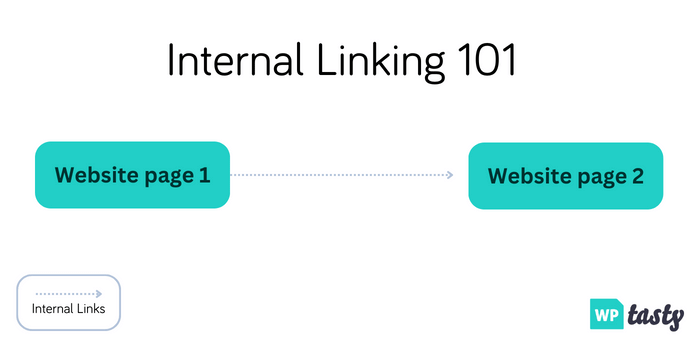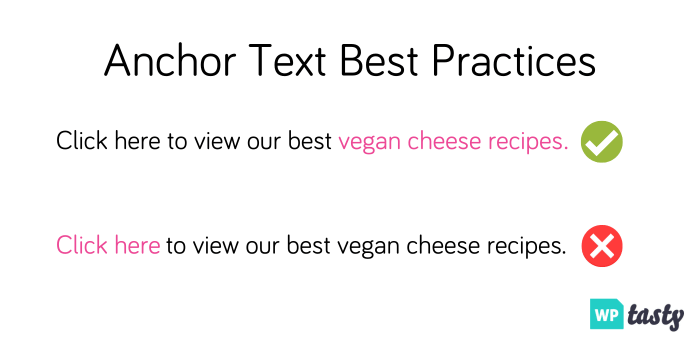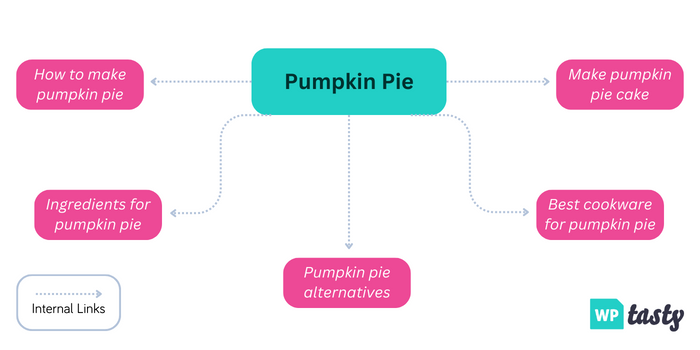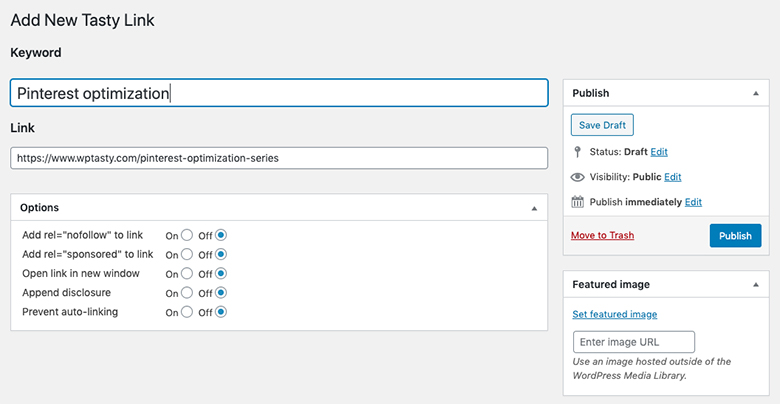If you don't optimize internal links on your website, you won't rank.
It's as simple as that. A website that doesn't link to other content on the site is like having a map without roads. Search engines and visitors can see the different places that exist, but they have no idea how to get there!
But internal link optimization seems difficult. How can you possibly learn how to do it right?
Well, you've come to the right place! We'll be your guide as we start filling out the map. This way, Google and website visitors can cruise your website without detours ?
So, let's dive in.
- What are internal links?
- Why are internal links important?
- The balance between internal and external links
- Anchor text & internal linking: A love story
- Tips to optimize website structure with internal links
- Creating topic clusters through internal linking
- Tools for internal link optimization
- Internal linking optimization frequently asked questions
What are internal links?
Before we can go anywhere, let's explain what internal links are.
Internal links are hyperlinks that connect one page of your website to another page on the same website. These links help people find related information and continue to explore your site.

When you visit a website, you find internal links pointing everywhere.
In the navigation menu, on the homepage, and in the content. Heck, you can even find them in the footer of the website!
And the more you link to your pages, the more value they get. (More on this in a bit).
Why are internal links important?
Internal linking doesn't only help your website visitors!
Internal links also play a huge role in search engine optimization (SEO). You see, search engines use bots to “crawl” your website and understand its structure.
When you create an internal link, you tell search engines the linked page is relevant to the content on the linking page.
Let's look at an example.
You have a blog post about the “10 Best Vegan Recipes for Families.” In that post, you may link to other blog posts on your site. These posts can talk about similar topics, like “How to Make Vegan Cheese”, or “How a Vegan Diet Can Help You.”
So, readers find more of the content they're looking for (yay!) ?️. Search engines understand your site (double yay!) ?️?️. And you pass “link juice” to other pages (triple yay!) ?️?️?️.
Wait, link juice? Is that something children sell at a lemonade stand?
Not exactly.
Link juice is a fun term to describe the value a link passes from one page to another. For example, when you link from a high-authority page to a low-authority page. You “pass” some of that authority to the linked page.
If you do this right, it can lead to huge jumps in your rankings!
So let's recap.
Internal linking helps:
- Readers navigate your site more easily, finding more of your content ✅
- Search engines crawl your website more easily, which helps them find all of your posts and pages ✅
- Pass link juice from high-authority pages to low-authority pages, improving your overall rankings ✅
The balance between internal and external links
We've learned about internal links.
Now let's take a look at its sibling: external links.
External links point to pages on other websites. For example, links to resources, news, or even Wikipedia count as external links.
But why are we telling you about external links? You came here for internal link tips!
Balancing your internal and external links is another important part of shooting up in the rankings faster than a rocket to the moon ?!
Having too many internal links makes your visitor feel like a mouse in a maze. But having too many external links hurts your website's authority.
So you need to find the perfect balance between the two ⚖️.
But finding the right balance between internal and external links can feel like walking on a ridge.
Sway too much to one side, and you risk falling off the cliff and hurting your website. Go too far on the other side, and you may get the same result.
So consider the purpose of each link.
Internal links should guide users to relevant content and help them find the information they need. External links should provide context, whether it's facts, extra information, or resources.
Ideally, most of your links are internal to help readers and search engines explore your site. External links should be used strategically on your site, only linking when it's necessary or helpful. They also help with link building, but that's a subject for another post.
But once you find this balance, you'll see HUGE rewards.
Anchor text & internal linking: A love story
Ahh, anchor text and internal linking.
A love story as old as time, but one that gets overlooked.
Anchor text is the clickable text used to create a link. For example, if you link to a page about the best vegan cheese recipes, your anchor text may be “vegan cheese recipes”.

There are two reasons for this:
- It tells users what the linked page is about
- Search engines, like Google, understand what the page is about
While both are important, the second one is crucial.
By using relevant and descriptive anchor text, you help search engines understand the context of the linked page. And that makes it easier for them to crawl your content and get it into their index.
If you use simple text like, “click here” or “read more” (we're looking at you, bloggers!), you can't tell what the page is about. There's no context, no keywords, and it's not the most engaging way of linking.
Instead, use descriptive anchor text and include relevant keywords.
Why use keywords?
Well, you may have guessed it already, but it helps improve your rankings for those keywords!
But, you don't want to overdo it. Don't use the same keyword over and over or use the title as the anchor text. Search engines see this as spammy, and you could hurt your site more than you help.
Plus, readers love descriptive anchor text! They're more likely to click if the text gives context and describes the content.
So that's a win-win! Search engines and readers love it? Does it get much better than that?
Tips to optimize website structure with internal links
Now that we've got the “what” and “why” out of the way, let's dive into some best practices.
Here are some tips to optimize your website's internal link structure:
1. Build a pyramid structure
The optimal structure for your website's internal links looks like a pyramid.
On top of the pyramid is your homepage.
This structure has a small number of links between the homepage and other pages. This lowers your crawl depth, which shows a page's “distance” from the homepage. The lower this number is, the better it is for your site's SEO because it's easier to find your content.
2. Use relevant anchor text
We touched on this above, but it's so important we thought we'd include it again.
Your anchor text can make or break your page's rankings. So put thought into these and add them carefully. Contextual links are the best way to go.
Your website will thank you later.
3. Keep your site's hierarchy in mind
Think of your site hierarchy as entering a house to find an item.
If there's stuff everywhere and no structure, you'll search for that item forever. And likely give up after a few hours (just like your readers and search engine bots).
The same is true for your internal links.
But if it's tidy and items are where they should be, you can find the item in seconds.
So, your homepage should have links to the most important pages on your site, or your pillar pages. Then those pages link to relevant subpages, and so on.
This keeps your site architecture clear and makes navigation much easier.
4. Use a logical URL structure
Your website's URL structure should be logical and easy to understand.
For example, let's look at two URL examples:
- https://www.myawesomewebsite.com/blog/why-my-site-is-so-awesome
- https://www.myawesomewebsite.com/9e5t2/i?hxd=tr58203&src=2081
Which one gives you the best idea of what the page is about?
That's right, the first one. And that's because it's following the rules we've talked about in this article!
Descriptive? ✅
Keywords? ✅
So take the time to get your URLs right.
5. Fix broken links
Going back to our map analogy, broken links are like dead ends.
People follow the path, drive down a road that goes nowhere, and end up frustrated with their map.
In this situation, your website is the map. And if you're linking to webpages that no longer exist or have an error, your readers will be very frustrated. But it's even worse when you know search engines don't like them, either! And they can hurt your rankings because bots can't crawl your website easily.
Now you're the one that's frustrated!
But you can fix these easily by using Google Search Console (GSC), Semrush, Ahrefs, or another service that scans your website and finds them for you.
Then you just have to fix the link, and your site is back on track!
Creating topic clusters through internal linking
One great way to optimize your internal linking strategy is through topic clusters.
Topic clusters are related content groups that link together through a central pillar page.

By creating topic clusters, you improve the relevance and authority of your website on a topic. And that makes it more attractive to visitors and search engines.
To get started, identify your pillar pages. These are high-level content pieces that give broad information about a topic.
Then, you begin developing topic clusters for each of them. These are more specific and dive deeper into a subject to explore it more than the pillar page can.
For example, here's how a topic cluster for pumpkin pie may look:

So, you have your pillar page, which internally links to all of your supporting pages. And your supporting pages all internally link back to your pillar page.
This way, you end up with a giant (but clear) web of links that visitors and search engines can easily navigate.
Tools for internal link optimization
Okay, you're now an internal linking wizard.
But no wizard is at their best without their wand. And, in this case, your wand is the internal linking WordPress plugin you use to help your internal linking strategy.
Luckily, there's no shortage of tools to use. Here are a few of the most useful ones to consider:
Tasty Links
Tasty Links is the perfect plugin for your links — external and internal.

It allows you to easily auto-link keywords. For example, we could make it so that every time we type “internal links” in our website's content, it automatically adds WordPress internal links to this post!
This way, you don't have to remember each and every post on your website and what anchor text you want to use — Tasty Links does it for you!
Plus, you can choose to add nofollow tags, open in a new window, and more!
This is great for internal linking or adding affiliate links so you can make some extra cash!
SEMrush
SEMrush is another useful tool that can help you optimize your internal links.
It gives you a complete analysis of your website's SEO performance, including your internal links.
You can use SEMrush to identify your most linked-to pages, your most linked-from pages, and your most common anchor text. And it even shows you your top-performing keywords so you know what to use to improve your rankings even more!
All In One SEO (AIOSEO)
AIOSEO is a great tool to improve your SEO strategy overall.
But its Link Assistant is an amazing tool to get a handle on your internal linking. It analyzes your posts and gives you a breakdown of how many orphaned posts (pages with no links to them), internal & external links, and affiliate links you have on your site.
It even recommends linking opportunities for you to take the hard work out of your hands!
Yoast SEO
Yoast SEO works similarly to AIOSEO.
And that's thanks to its internal linking tool. This simple tool helps find pages for internal links so you can quickly add them and raise your website's rankings quickly!
It doesn't hurt that Yoast is one of the most trusted SEO tools for WordPress.
Spreadsheet
More of a “do-it-yourself” type of person?
Then using a spreadsheet to manage your internal links is an effective technique.
Easily track your internal links, including the pages they link from and the pages they link to. You can also use a spreadsheet to analyze your anchor text distribution and identify opportunities to improve it.
While it requires a bit more work than other tools on this list, it's a great (free!) option.
Internal linking optimization frequently asked questions
What are the benefits of internal linking for SEO?
Internal linking has several benefits for SEO, such as:
- Search engines understand your website structure
- It spreads link equity throughout your website
- Improves the user experience, which leads to higher page times and lower bounce rates
How can I improve my internal linking?
To improve your website's internal linking, start by creating a site map to outline the hierarchy of your pages.
Then, use internal links to connect related pages to continue building our your site's structure. But make sure to use descriptive anchor text that reflects the linked page's content.
What is the importance of anchor text in internal links?
Anchor text gives search engines and readers context about the linked page.
So when a bot crawls your page or a reader goes to click the link, they have an idea of what the page will be about before they visit.
When creating internal links, use descriptive and relevant anchor text that describes the content of the page.
How can I perform an internal link audit?
To perform an internal link audit, start by identifying all of the internal links on your website.
Then, evaluate the quality and relevance of each link, making sure they are accurately describing the content of the linked page.
You should also ensure there are no broken links or links that are pointing to outdated or irrelevant content.
What is the ideal number of internal links on a page for SEO?
There is no specific number of internal links that is ideal for SEO.
Instead, focus on creating a clear and logical internal linking structure that helps users navigate your website and provides context to search engines about the content of your pages.
Make sure to avoid overloading your pages with too many internal links, as this makes it difficult for users to navigate and can be seen as spammy by search engines.
What is the role of external linking in internal link optimization?
External linking can play a role in internal link optimization by providing additional context and authority to your pages.
When you link to high-quality external sources, you are signaling to search engines that your content is relevant and valuable.
However, it is important to make sure that your external links are relevant and authoritative, as linking to low-quality or spammy sources has a negative impact on your SEO.
Ready to optimize internal links on your site?
There you have it, your one-stop shop guide for internal link optimization for SEO.
This all may seem complicated. But once you start practicing, it'll be second nature!
We hope this guide helped. And if you're ready to get started, grab Tasty Links and get to work!

